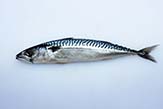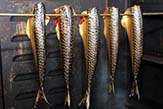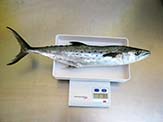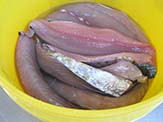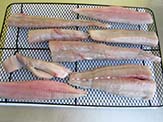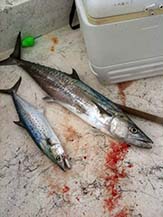Meats and Sausages
Mackerel - Atlantic
Fish RecipesMackerel-Atlantic (Scomber scombrus), Protein-18.60%, Fat-13.89%, Water-63.55%
Scomber scombrus is sometimes called Atlantic, northern or Boston mackerel to distinguish it from Scomber japonicus, which is variously called chub, Pacific, or Spanish mackerel. The back of the Atlantic mackerel is a brilliant greenish blue, and the head is a steely blue-black with a small yellow patch behind the eye. There are 23-33 dark wavy bands across the back of the fish down to the midline. The sides have a silvery or coppery sheen, the belly is silvery white and there is a broken black line just below the lateral line. The scales are small and the skin feels velvety. An adult mackerel 30-35 cm long weighs 300-500 g before gutting. The mackerel is a fatty fish, and the fat and water content vary with season. The fat content of mackerel caught off south west England is lowest in May after spawning, and reaches its peak between October and December after the fish have fed during the summer and autumn. A typical range of fat content throughout the year is 6-23 per cent. As fat content increases, water content decreases; the typical range of water content is 56-74 percent. The protein content is 18-20 percent.
Gutted mackerel may be split down the back in the same way as herring are prepared for kippering. A split mackerel of average size and fat content requires 7 minutes in 80° brine. The fish may also be cut as single or block fillets; brining time is 3 minutes in 80° brine. (Add 2.2 lbs of salt to 1 gallon of water. This makes 80 degrees brine).
Hot Smoked Atlantic Mackerel
1. Wash the fish, cut the head off, split the belly and remove the entrails. Use a brush to scrape off kidneys. Rinse and drain.
2. Brine the fish for 10 minutes in 80º brine. Rinse and drain. Insert on rods (Photo 4.9).
3. Dry fish for 60 minutes in a preheated to 100° F (38° C) smokehouse. Light smoke is allowed.
4. Apply a dense smoke for 60 minutes at 185° F (85° C). Switch off the heat and smoke for 15 more minutes.
Mackerel - Spanish
(Scomber japonicus, Scomberomorus maculatus), Protein-19.29%, Fat-6.30%, Water-71.67%
The Spanish mackerel prefers warm waters and is a common fish in Florida. It looks similar to the Atlantic mackerel, but is bigger and instead of wavy bands, there are large dots on its sides.
Hot Smoked Spanish Mackerel
4. Insert into a preheated to 100° F (38° C) smokehouse and apply light smoke for 60 minutes.
5. Apply a dense smoke for 60-90 minutes at 185° F (85° C).
Mackerel-King
(Scomberomorus cavalla)
Protein-20.28%, Fat-2%, Water-78.55%
The king mackerel is a migratory species of mackerel of the western Atlantic Ocean and Gulf of Mexico. The king mackerel is a medium-sized fish, typically encountered from five to 30 pounds, but is known to exceed 90 pounds. Fish under 10 pounds (5 kg) show yellowish-brown spots on the flanks, somewhat smaller than the spots of the Atlantic Spanish mackerel. They may be sold as fillets, steaks,or in the round (whole). Their raw flesh is grayish, due to its high fat content. They are best prepared by broiling, frying, baking or, especially for large “smoker” king, by smoking.
Smoked King Mackerel
- Fillet the fish. Rinse.
- Immerse in 80º brine for 10 minutes. Rinse and drain.
- Air dry for 1 hour.
- Apply a light smoke at 100° F (38° C) for 60 minutes.
- Apply a dense smoke for 90 minutes at 185° F (85° C).

